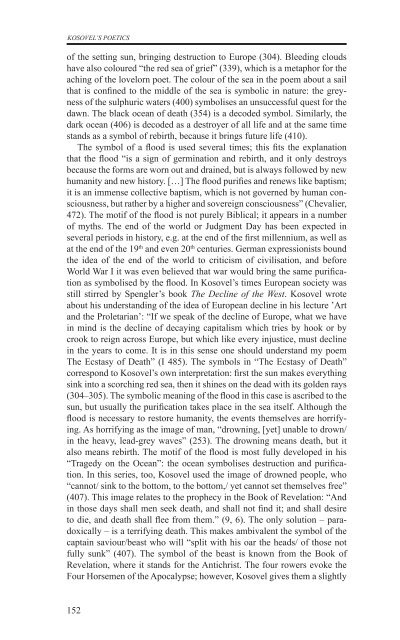razprave (pdf) - Društvo za primerjalno književnost - ZRC SAZU
razprave (pdf) - Društvo za primerjalno književnost - ZRC SAZU
razprave (pdf) - Društvo za primerjalno književnost - ZRC SAZU
- No tags were found...
You also want an ePaper? Increase the reach of your titles
YUMPU automatically turns print PDFs into web optimized ePapers that Google loves.
KOSOVEL’s poeticsof the setting sun, bringing destruction to Europe (304). Bleeding cloudshave also coloured “the red sea of grief” (339), which is a metaphor for theaching of the lovelorn poet. The colour of the sea in the poem about a sailthat is confined to the middle of the sea is symbolic in nature: the greynessof the sulphuric waters (400) symbolises an unsuccessful quest for thedawn. The black ocean of death (354) is a decoded symbol. Similarly, thedark ocean (406) is decoded as a destroyer of all life and at the same timestands as a symbol of rebirth, because it brings future life (410).The symbol of a flood is used several times; this fits the explanationthat the flood “is a sign of germination and rebirth, and it only destroysbecause the forms are worn out and drained, but is always followed by newhumanity and new history. […] The flood purifies and renews like baptism;it is an immense collective baptism, which is not governed by human consciousness,but rather by a higher and sovereign consciousness” (Chevalier,472). The motif of the flood is not purely Biblical; it appears in a numberof myths. The end of the world or Judgment Day has been expected inseveral periods in history, e.g. at the end of the first millennium, as well asat the end of the 19 th and even 20 th centuries. German expressionists boundthe idea of the end of the world to criticism of civilisation, and beforeWorld War I it was even believed that war would bring the same purificationas symbolised by the flood. In Kosovel’s times European society wasstill stirred by Spengler’s book The Decline of the West. Kosovel wroteabout his understanding of the idea of European decline in his lecture ’Artand the Proletarian’: “If we speak of the decline of Europe, what we havein mind is the decline of decaying capitalism which tries by hook or bycrook to reign across Europe, but which like every injustice, must declinein the years to come. It is in this sense one should understand my poemThe Ecstasy of Death” (I 485). The symbols in “The Ecstasy of Death”correspond to Kosovel’s own interpretation: first the sun makes everythingsink into a scorching red sea, then it shines on the dead with its golden rays(304–305). The symbolic meaning of the flood in this case is ascribed to thesun, but usually the purification takes place in the sea itself. Although theflood is necessary to restore humanity, the events themselves are horrifying.As horrifying as the image of man, “drowning, [yet] unable to drown/in the heavy, lead-grey waves” (253). The drowning means death, but italso means rebirth. The motif of the flood is most fully developed in his“Tragedy on the Ocean”: the ocean symbolises destruction and purification.In this series, too, Kosovel used the image of drowned people, who“cannot/ sink to the bottom, to the bottom,/ yet cannot set themselves free”(407). This image relates to the prophecy in the Book of Revelation: “Andin those days shall men seek death, and shall not find it; and shall desireto die, and death shall flee from them.” (9, 6). The only solution – paradoxically– is a terrifying death. This makes ambivalent the symbol of thecaptain saviour/beast who will “split with his oar the heads/ of those notfully sunk” (407). The symbol of the beast is known from the Book ofRevelation, where it stands for the Antichrist. The four rowers evoke theFour Horsemen of the Apocalypse; however, Kosovel gives them a slightly152
















